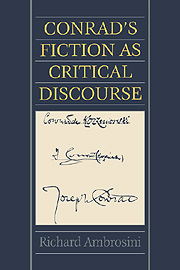Book contents
- Frontmatter
- Contents
- Acknowledgments
- List of abbreviations
- Introduction
- 1 The critical discourse: five tropes
- 2 Working on language and structure: alternative strategies in The Nigger of the “Narcissus” “Karain” and “Youth”
- 3 The mirror effect in “Heart of Darkness”
- 4 Lord Jim (I): the narrator as interpreter
- 5 Lord Jim (II): the narrator as reader
- Postscript
- Notes
- Bibliography
- Index
5 - Lord Jim (II): the narrator as reader
Published online by Cambridge University Press: 05 January 2012
- Frontmatter
- Contents
- Acknowledgments
- List of abbreviations
- Introduction
- 1 The critical discourse: five tropes
- 2 Working on language and structure: alternative strategies in The Nigger of the “Narcissus” “Karain” and “Youth”
- 3 The mirror effect in “Heart of Darkness”
- 4 Lord Jim (I): the narrator as interpreter
- 5 Lord Jim (II): the narrator as reader
- Postscript
- Notes
- Bibliography
- Index
Summary
The Patusan romance is an adaptation of the narrative form to the conclusions of Marlow's analytic inquiry. Conrad's highest achievement in the use of the narrative frame, Marlow's probing of Jim's case, had been launched as an attempt to make explicit those words that Jim could not utter. To this purpose, Conrad articulated a symbolically suggestive language decodable through a rhetorical commentary which made possible a direct line of communication between author and reader. As it turns out, however, once the internal narrator discovers why the young man matters to him, the truth of these unutterable words comes to be warranted by the reality of Jim's (and Marlow's) illusions. The interpretation of the issues raised by Jim's fateful jump evolved in such a way as to reveal that only by increasing the fiction's fictionality could the author force on the readers a sense of the protagonist's “existence.” Thus, the content of the analytical discourse itself comes to support the basis of fiction: the potentiality of human acts is no less true than the “naked fact” (35) which is their actuality. This is why Conrad will not use Marlow in Patusan as a device for questing after that right word which could disclose Jim's subjective point of view. Instead, the narrator becomes an ideal reader whose reality has been touched by the truth of Jim's illusion.
- Type
- Chapter
- Information
- Conrad's Fiction as Critical Discourse , pp. 142 - 175Publisher: Cambridge University PressPrint publication year: 1991



